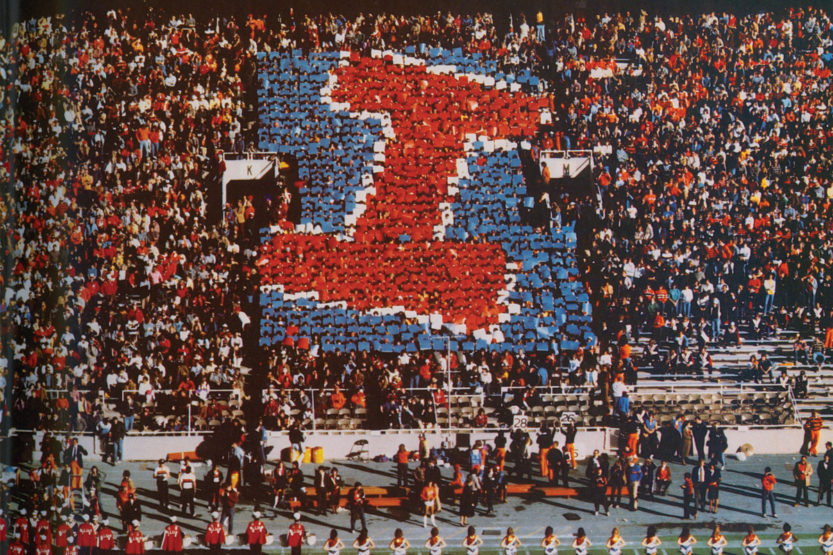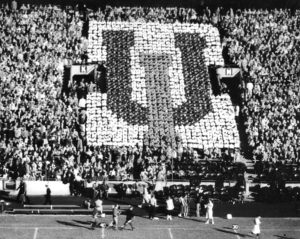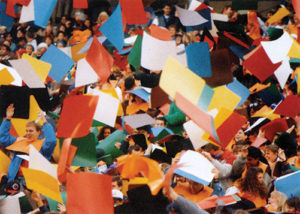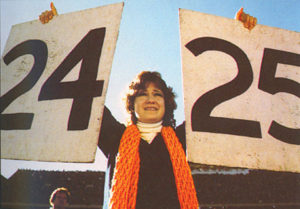Memory Lane: building blocks
 In 1985, the Block I cheering section boasted some 1,100 students. (1985 Illio photo)
In 1985, the Block I cheering section boasted some 1,100 students. (1985 Illio photo) Karen Keuss, ’69 ACES, likes to tell her friends that she appeared in Playboy.
Indeed, Keuss does appear in the magazine’s September 1968 issue—in a photo accompanying the annual Playboy “Pigskin Preview.” But there’s a catch: She can’t actually be seen in the photo, at least not clearly. It depicts the University of Illinois’ Block I student cheering section, arranged in the form of the iconic Playboy bunny. Keuss was one of the 2,000-plus “Blockheads” present at Memorial Stadium for the card stunt that took place during a November 1967 game against Michigan.

The 1962 Block I members create the University of Illinois logo in the east stands. (UI Archives photo)
“We know approximately where we sat in the East Block I, so we point out that we were in the seats and part of that picture,” says Keuss, speaking of herself and her husband, Alan Keuss, ’69 ENG. “Thus, my appearance in the magazine is a fact, and our Playboy claim to fame is real!”
Whether they are replicating the shape of the Playboy bunny, an unfurling American flag, the Alma Mater or a tilting beer mug, Block I card flashers have a long history of entertaining football fans, fostering school spirit and having fun.
The University had a Rooters Association as early as 1903, and the first Homecoming game in 1910 featured a cheering section arranged in a block “I,” but the real beginning of the modern Block I dates back to 1921. That year, Sachem, a junior honor society, organized a football rooting section that soon would become “an institution,” in the words of The Daily Illini.
In its inaugural year, the so-called Sachem Block I had 144 members, all juniors and seniors and all male. Arrayed in the east bleachers of old Illinois Field in the form of a large orange “I,” and outfitted with orange caps and megaphones, they “cheered the team—cheered them when they made their downs and cheered them when they lost,” the student newspaper reported. “The Sachem Block I bound the whole east bleachers together in a way that has not been possible before. The thousands on that stand cheered with one voice, like the manifold paean of a mighty symphony.”

Block I members throw their cards in the air at the end of the 1992 half-time show, (1992 Illio photo)
As its membership grew over the years—by 1927, there were 884 members—the Sachem Block I also expanded its repertoire of stunts. Around 1928, Block I—then lodged in the east stands of the newly built Memorial Stadium—began using cards to spell out words; two years later, it added pictures to its act.
During the Great Depression, the falling fortunes of Illinois football caused Block I membership to plummet. Hoping to “fill the block,” Sachem started admitting women in 1931. Male chauvinists howled in indignation. “When cheering was originated, I think it was intended to come from the throats of the bass sex, and not from the women, who, even at the height of their enthusiasm, send forth false falsettos that couldn’t be heard 10 yards away on a bet,” Daily Illini student-columnist Elston D. “El” Herron, ’32 LAS, ’32 MEDIA, wrote.
A victim of apathy, the first incarnation of Block I died a slow death. The University’s military department agreed to sponsor Block I in 1937 after it was abandoned by Sachem. But when there weren’t enough ROTC students to fully populate the student section, Block I (version 1.0) finally expired in 1939.
But Illini spirit revived after World War II, and Block I made a big comeback. In 1946, the War Whoops pep club launched a new Block I, numbering 884 students, but real credit for the rebirth goes to Barbara Shade, ’49 ACES, Block I’s major chairperson in 1948, who had learned how to do elaborate card stunts while attending the University of Southern California. Keith Goodwin, ’50 ENG, credited Shade with introducing new Block I “techniques of stunt preparation and presentation, flash card manipulation and most other aspects of card-section techniques still in use today.” She also eliminated the cumbersome 16-by-20-inch plywood cards that “caused a few scalp cuts when members attempted to flip them or search out another color,” Goodwin noted.

“Blockhead” Laurie Lancisi, ’84 FAA, march ’86, indicates the number for the next stunt. (1985 Illio photo)
The innovations continued. In 1954, a spirited rivalry was created when the West Block was added, doubling the size of Block I. (The West Block’s last full season was in 1978.) In the late 1960s, Block I members began flashing fluorescent cards and, for the first time, mainframe computers were used to print out stunt instruction cards for each member. In the 1980s, IBM personal computers were enlisted to aid card stunt design, and plastic cards replaced cardboard ones. And in 2007, Block I moved to new stands on the north end of the field as part of a major Memorial Stadium renovation.
Block I members always seem to enjoy themselves—regardless of the score. “I was in Block I from 1969 to 1972,” V. Kathleen Elmore, ’72 FAA, MA ’91 UIS, recalls. “It was a great time, and we lost almost every game! We were true fans.”

